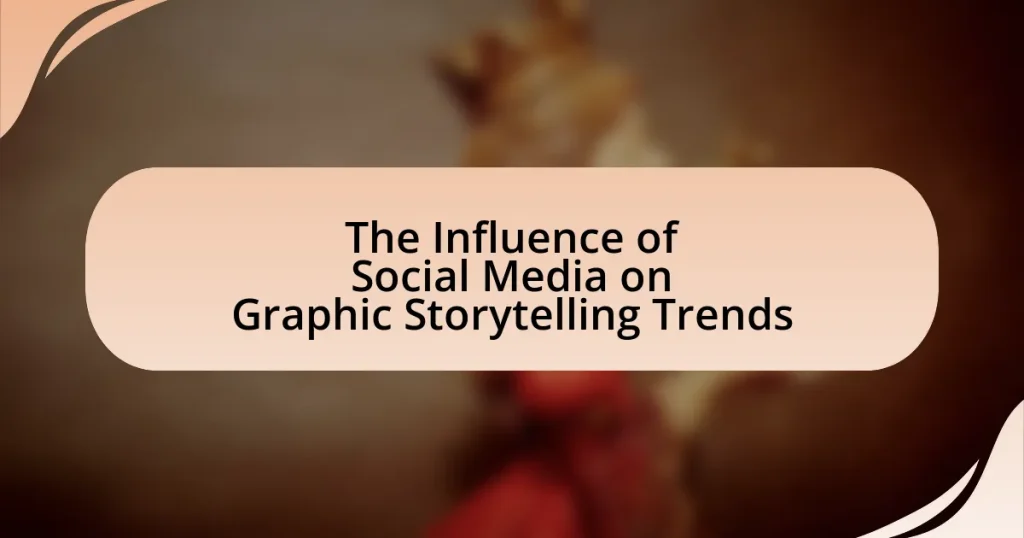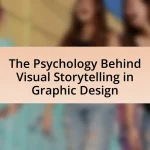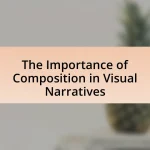The article examines the significant influence of social media on graphic storytelling trends, highlighting how platforms like Instagram, TikTok, and Webtoon have transformed narrative styles and audience engagement. It discusses the emergence of short-form content, interactive storytelling, and user-generated contributions, which have reshaped traditional graphic storytelling methods. Key trends include the rise of webcomics, the impact of visual aesthetics, and the importance of analytics in refining storytelling approaches. Additionally, the article addresses the challenges creators face in a saturated market and offers practical tips for maintaining authenticity while adapting to social media dynamics.
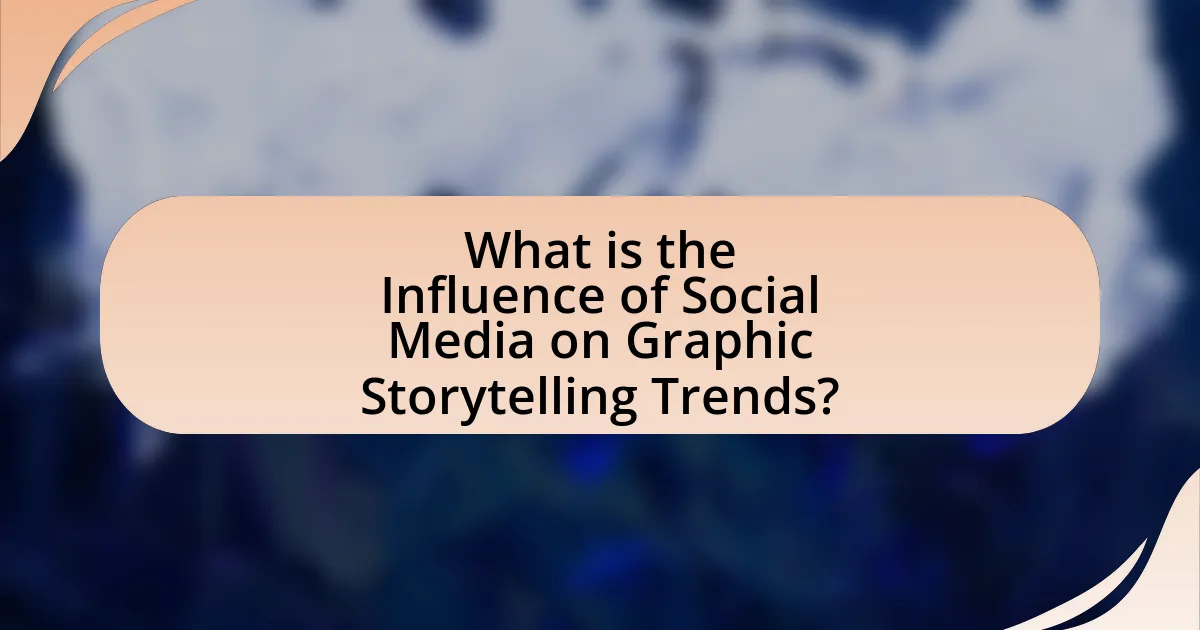
What is the Influence of Social Media on Graphic Storytelling Trends?
Social media significantly influences graphic storytelling trends by enabling rapid dissemination and engagement with visual narratives. Platforms like Instagram and TikTok allow creators to share their graphic stories widely, leading to the emergence of new styles and formats that cater to shorter attention spans. For instance, the rise of webcomics and visual storytelling formats, such as infographics and animated shorts, can be attributed to the need for quick, engaging content that resonates with social media audiences. Additionally, user-generated content and interactive storytelling have gained traction, as creators leverage audience feedback and participation to shape their narratives, reflecting a shift towards more collaborative and dynamic storytelling methods.
How has social media changed the landscape of graphic storytelling?
Social media has transformed graphic storytelling by providing platforms for immediate sharing and audience engagement. This shift allows creators to reach global audiences instantly, fostering diverse narratives and styles that were previously limited by traditional publishing constraints. For instance, platforms like Instagram and TikTok enable artists to showcase their work in visually dynamic formats, leading to the rise of webcomics and short animated stories. According to a 2021 survey by the Pew Research Center, 69% of adults in the U.S. use social media, highlighting its role in democratizing content creation and distribution. This accessibility has empowered emerging artists to gain visibility and build communities around their work, fundamentally altering the landscape of graphic storytelling.
What specific platforms have the most impact on graphic storytelling?
Instagram, Webtoon, and TikTok are the specific platforms that have the most impact on graphic storytelling. Instagram allows creators to share visual narratives through images and short videos, fostering engagement and community interaction. Webtoon provides a dedicated space for webcomics, enabling artists to reach a global audience and monetize their work through a subscription model. TikTok’s short-form video format encourages innovative storytelling techniques, allowing creators to experiment with narrative styles and reach younger demographics. These platforms collectively shape trends in graphic storytelling by facilitating accessibility, audience engagement, and diverse narrative forms.
How do user interactions on social media shape storytelling techniques?
User interactions on social media significantly shape storytelling techniques by providing real-time feedback and engagement metrics that inform content creation. This dynamic allows storytellers to adapt narratives based on audience preferences, as evidenced by platforms like Instagram and Twitter, where likes, shares, and comments directly influence the direction and style of stories. For instance, a study by the Pew Research Center found that 69% of adults in the U.S. use social media, indicating a vast audience whose reactions can guide the evolution of storytelling methods. Consequently, storytellers increasingly employ interactive elements, such as polls and user-generated content, to foster deeper connections and enhance narrative engagement.
Why is understanding this influence important for creators?
Understanding the influence of social media is crucial for creators because it shapes audience engagement and content dissemination. Social media platforms dictate trends, allowing creators to tailor their graphic storytelling to align with audience preferences and behaviors. For instance, a study by the Pew Research Center found that 72% of the public uses social media, highlighting its role in shaping cultural narratives. By recognizing these dynamics, creators can enhance their visibility and relevance in a competitive landscape, ultimately driving their success.
What opportunities does social media present for graphic storytellers?
Social media presents significant opportunities for graphic storytellers by providing platforms for wider audience reach and engagement. Graphic storytellers can share their work instantly with global audiences, leveraging platforms like Instagram, Facebook, and Twitter to showcase their narratives visually. This accessibility allows for immediate feedback and interaction, fostering community building and collaboration among creators. Additionally, social media algorithms can enhance visibility, enabling storytellers to gain traction and recognition more rapidly than traditional media channels. According to a 2021 report by Hootsuite, over 4.2 billion people use social media worldwide, highlighting the vast potential audience for graphic storytelling.
How can creators leverage social media trends to enhance their work?
Creators can leverage social media trends by actively engaging with current popular themes and formats to enhance their work. By analyzing trending hashtags, challenges, and content styles on platforms like Instagram, TikTok, and Twitter, creators can identify what resonates with audiences. For instance, the rise of short-form video content has led many graphic storytellers to adapt their narratives into bite-sized, visually engaging clips, which can increase viewer engagement and shareability. According to a report by HubSpot, 54% of consumers want to see more video content from brands they support, indicating that aligning with this trend can significantly boost a creator’s visibility and relevance in the market.
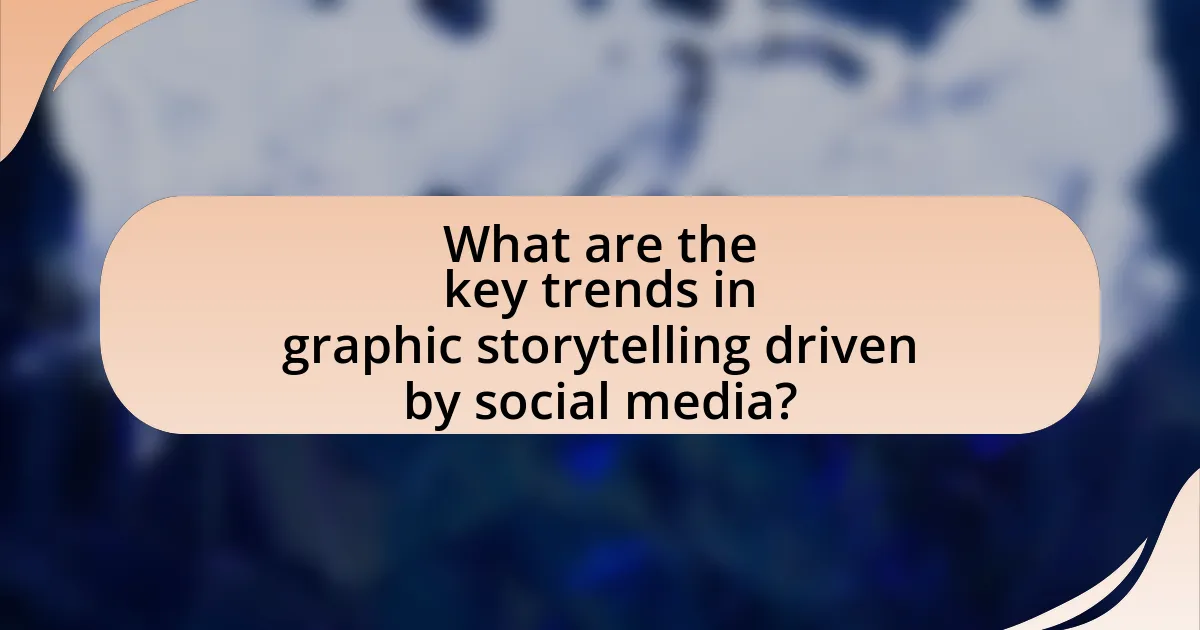
What are the key trends in graphic storytelling driven by social media?
Key trends in graphic storytelling driven by social media include the rise of short-form content, increased interactivity, and the use of diverse visual styles. Short-form content, such as Instagram Stories and TikTok videos, has gained popularity, allowing creators to convey narratives quickly and engagingly. Increased interactivity is evident in platforms that enable audience participation, such as polls and comments, fostering a two-way communication dynamic. Additionally, diverse visual styles, including memes and infographics, reflect cultural trends and resonate with varied audiences, enhancing relatability and shareability. These trends are supported by statistics showing that 60% of users prefer visual content over text, highlighting the effectiveness of graphic storytelling in capturing attention on social media.
How do visual aesthetics evolve with social media influence?
Visual aesthetics evolve with social media influence by adapting to user preferences and platform-specific trends. As social media platforms prioritize visual content, designers and creators respond by developing aesthetics that are more engaging and shareable, often characterized by bold colors, minimalism, and dynamic compositions. For instance, Instagram’s emphasis on visually appealing images has led to a rise in curated feeds that prioritize cohesive color palettes and high-quality photography. This shift is supported by data showing that posts with strong visual elements receive significantly higher engagement rates, with studies indicating that images can increase engagement by up to 650% compared to text-only posts. Consequently, the evolution of visual aesthetics is closely tied to the demands and behaviors of social media users, driving continuous innovation in graphic storytelling.
What role does user-generated content play in shaping visual styles?
User-generated content significantly influences visual styles by introducing diverse perspectives and innovative aesthetics that reflect the preferences of a broader audience. This content, often shared on social media platforms, allows creators to experiment with various visual elements, leading to the emergence of new trends. For instance, platforms like Instagram and TikTok have popularized specific color palettes, typography, and design layouts that resonate with users, as evidenced by the rise of minimalist and retro styles in graphic design. Additionally, user engagement with this content can drive the popularity of certain visual trends, as seen in the viral nature of specific design challenges or aesthetic movements, reinforcing the idea that user-generated contributions are pivotal in shaping contemporary visual styles.
How do viral trends affect the narrative structure of graphic stories?
Viral trends significantly influence the narrative structure of graphic stories by shaping themes, pacing, and character development. These trends often dictate popular topics and styles, compelling creators to adapt their narratives to align with audience expectations and cultural conversations. For instance, the rise of meme culture has led to the incorporation of humor and brevity in storytelling, as seen in graphic novels like “Sarah’s Scribbles,” which reflects relatable, everyday experiences in a concise format. Additionally, the rapid dissemination of content through social media platforms encourages creators to utilize cliffhangers and episodic structures to maintain audience engagement, as evidenced by the success of webcomics that leverage these techniques to build anticipation and community interaction.
What are the emerging formats in graphic storytelling due to social media?
Emerging formats in graphic storytelling due to social media include short-form comics, webtoons, and animated GIFs. These formats cater to the fast-paced consumption habits of social media users, allowing creators to convey narratives quickly and visually. For instance, platforms like Instagram and TikTok have popularized the use of bite-sized comic strips and animated sequences, which can be easily shared and engaged with. According to a study by the Pew Research Center, 72% of teens use Instagram, highlighting the platform’s role in shaping visual storytelling trends. Additionally, webtoons have gained significant traction, with platforms like LINE Webtoon reporting millions of monthly readers, demonstrating the demand for serialized graphic content that fits mobile viewing preferences.
How have short-form content and micro-narratives gained popularity?
Short-form content and micro-narratives have gained popularity primarily due to the rise of social media platforms that prioritize quick, engaging interactions. Platforms like TikTok, Instagram, and Twitter encourage users to create and consume bite-sized content, making it easier for audiences to digest information rapidly. According to a report by HubSpot, 54% of consumers prefer short-form video content, highlighting a significant shift in content consumption preferences. This trend is further supported by the fact that attention spans have decreased, with studies indicating that the average human attention span has dropped to around eight seconds, prompting creators to adapt their storytelling methods to fit this new norm.
What impact do stories and reels have on traditional graphic storytelling?
Stories and reels significantly transform traditional graphic storytelling by prioritizing brevity and immediacy, which alters narrative structures. These formats encourage creators to condense complex narratives into short, engaging snippets, often leading to a shift from detailed illustrations to more dynamic, visually striking content. Research indicates that platforms like Instagram report higher engagement rates for stories and reels, with users spending an average of 28 minutes per day on these features, which suggests a preference for quick, digestible content over longer graphic narratives. This trend challenges traditional storytelling methods, pushing creators to adapt their techniques to maintain audience interest in a fast-paced digital environment.
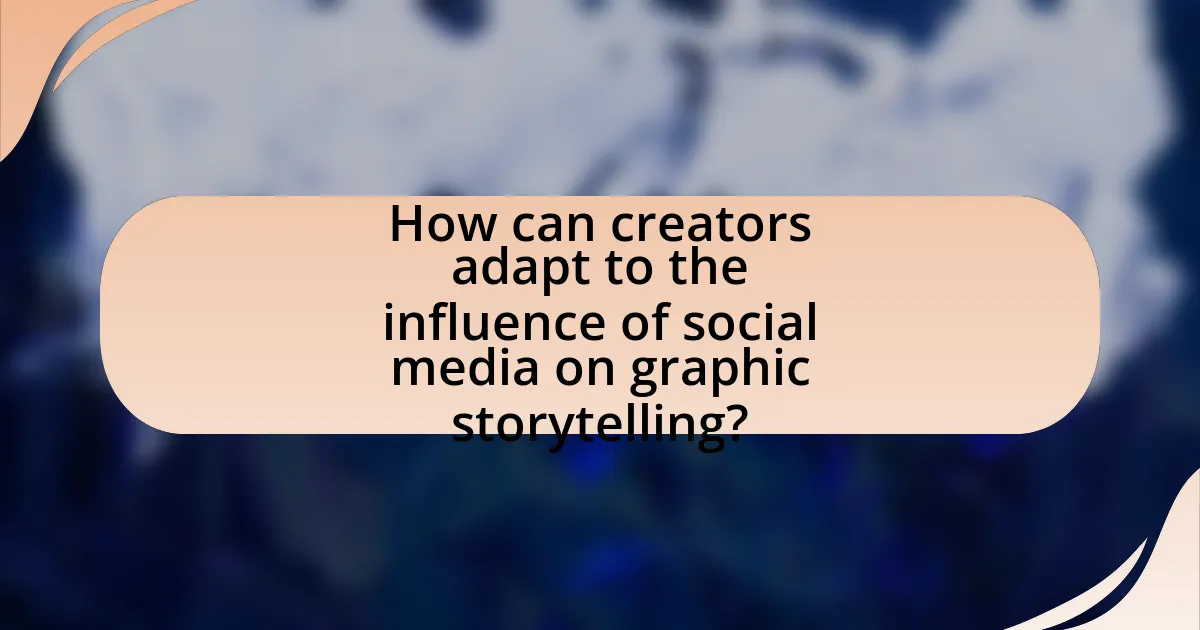
How can creators adapt to the influence of social media on graphic storytelling?
Creators can adapt to the influence of social media on graphic storytelling by leveraging platform-specific formats and engaging directly with their audience. By utilizing short, visually compelling content tailored for platforms like Instagram or TikTok, creators can capture attention quickly, as studies show that visual content is 40 times more likely to be shared on social media than other types of content. Additionally, incorporating interactive elements such as polls or Q&A sessions can foster community engagement, which is crucial for building a loyal following. This approach aligns with the trend that 70% of consumers prefer to learn about products through content rather than traditional advertising, highlighting the importance of adapting storytelling techniques to fit social media dynamics.
What strategies can graphic storytellers use to engage audiences on social media?
Graphic storytellers can engage audiences on social media by utilizing visually compelling narratives, interactive content, and consistent branding. Visually compelling narratives capture attention through striking imagery and cohesive story arcs, which are essential in platforms where visual content predominates. Interactive content, such as polls, quizzes, and user-generated challenges, encourages audience participation and fosters a sense of community. Consistent branding across posts helps establish a recognizable identity, making it easier for audiences to connect with the storyteller’s work. According to a study by HubSpot, posts with visuals receive 94% more views than those without, highlighting the effectiveness of visual storytelling in engaging audiences.
How can creators effectively use analytics to refine their storytelling approach?
Creators can effectively use analytics to refine their storytelling approach by analyzing audience engagement metrics, such as views, shares, and comments, to identify which elements resonate most with their audience. For instance, data from platforms like Instagram and Facebook can reveal which story arcs or visual styles generate the highest interaction rates, allowing creators to adjust their narratives accordingly. A study by the Pew Research Center found that 69% of adults in the U.S. use social media, indicating a significant audience that can provide valuable feedback through analytics. By leveraging these insights, creators can enhance their storytelling techniques, ensuring they align with audience preferences and trends.
What best practices should be followed for sharing graphic stories on social media?
To effectively share graphic stories on social media, creators should prioritize clarity, engagement, and audience sensitivity. Clarity ensures that the visual elements and narrative are easily understood, which is crucial for maintaining viewer interest. Engagement can be enhanced by using interactive elements such as polls or questions related to the story, fostering a connection with the audience. Additionally, sensitivity to the content is vital; creators must consider the emotional impact of graphic stories, especially when dealing with sensitive topics, to avoid causing distress or backlash. Research indicates that posts with clear visuals and engaging content receive 94% more views than those without, highlighting the importance of these best practices in maximizing reach and impact.
What common challenges do creators face in this evolving landscape?
Creators face several common challenges in the evolving landscape of social media and graphic storytelling, including oversaturation of content, algorithm changes, and audience engagement. The oversaturation of content makes it difficult for individual creators to stand out, as millions of posts compete for attention daily. Algorithm changes on platforms like Instagram and TikTok can drastically affect visibility and reach, often leaving creators uncertain about how to effectively promote their work. Additionally, maintaining audience engagement is challenging due to shifting viewer preferences and the need for constant innovation to keep content fresh and relevant. These challenges are supported by studies indicating that creators often struggle to adapt to rapid changes in platform dynamics and audience expectations, which can hinder their growth and success in the digital space.
How can creators overcome the saturation of content on social media?
Creators can overcome the saturation of content on social media by focusing on niche audiences and delivering unique, high-quality content. By identifying specific interests or underserved communities, creators can tailor their messages to resonate more deeply with their target audience. For instance, a study by the Pew Research Center indicates that niche content often garners higher engagement rates, as it caters to specific preferences and needs. Additionally, leveraging storytelling techniques that emphasize authenticity and personal experiences can differentiate creators in a crowded space, as audiences increasingly seek genuine connections over generic content.
What are the risks of relying too heavily on social media trends?
Relying too heavily on social media trends poses significant risks, including the potential for misinformation and the erosion of authentic storytelling. When creators prioritize trending topics over factual accuracy, they may inadvertently spread false narratives, as seen in various viral misinformation campaigns that have misled audiences. Additionally, an overemphasis on trends can lead to homogenized content, stifling creativity and originality in graphic storytelling. Research indicates that creators who follow trends closely often produce work that lacks depth and personal voice, which can disengage audiences seeking unique perspectives.
What practical tips can enhance graphic storytelling in the context of social media?
To enhance graphic storytelling in the context of social media, creators should focus on visual consistency, engaging narratives, and audience interaction. Visual consistency ensures that the style, color palette, and typography align across posts, which helps establish brand identity and recognition. Engaging narratives can be achieved by using compelling visuals that evoke emotions and tell a story, as studies show that emotional content is more likely to be shared on social media. Audience interaction can be fostered through polls, questions, and calls to action, encouraging viewers to participate and share their thoughts, which increases engagement rates. These strategies are supported by research indicating that posts with strong visual elements and interactive components receive higher engagement, making them more effective in capturing audience attention.
How can creators maintain authenticity while adapting to trends?
Creators can maintain authenticity while adapting to trends by staying true to their unique voice and values while selectively integrating popular elements. This approach allows creators to resonate with current audiences without compromising their core identity. For instance, a study by the Pew Research Center indicates that 64% of social media users appreciate content that reflects the creator’s genuine personality, suggesting that authenticity fosters stronger connections. By balancing personal style with trending topics, creators can engage effectively while preserving their distinctiveness.
What tools and resources are available for optimizing graphic storytelling on social media?
Tools and resources available for optimizing graphic storytelling on social media include Canva, Adobe Spark, and Piktochart, which provide user-friendly design templates and editing features. These platforms enable users to create visually appealing graphics tailored for various social media formats, enhancing engagement. Additionally, resources like Hootsuite and Buffer assist in scheduling posts and analyzing performance metrics, allowing for data-driven adjustments to storytelling strategies. Research indicates that visual content is 40 times more likely to be shared on social media, underscoring the importance of effective graphic storytelling tools in maximizing reach and impact.
